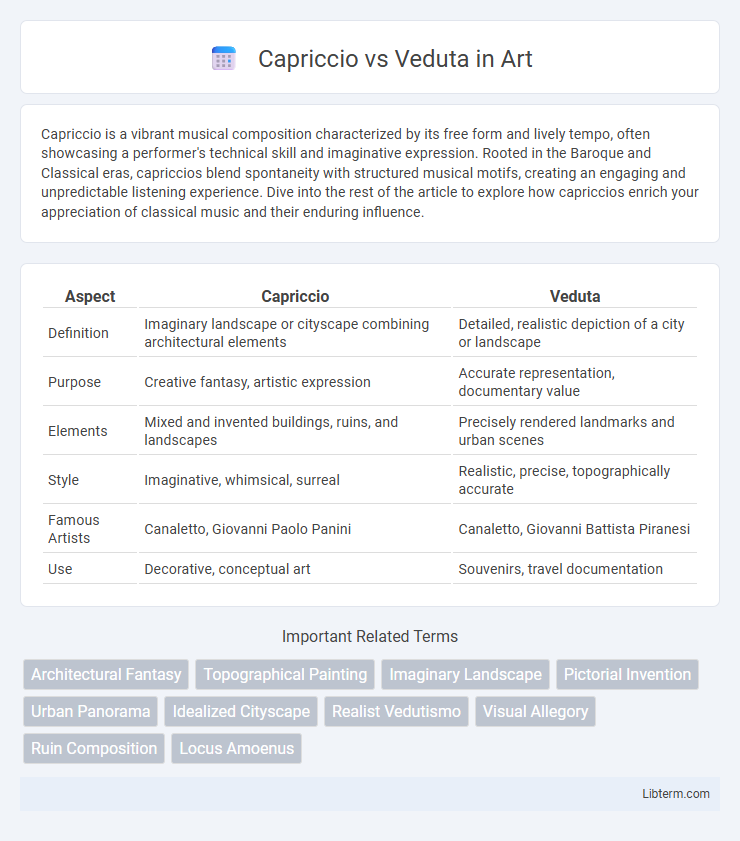Capriccio is a vibrant musical composition characterized by its free form and lively tempo, often showcasing a performer's technical skill and imaginative expression. Rooted in the Baroque and Classical eras, capriccios blend spontaneity with structured musical motifs, creating an engaging and unpredictable listening experience. Dive into the rest of the article to explore how capriccios enrich your appreciation of classical music and their enduring influence.
Table of Comparison
| Aspect | Capriccio | Veduta |
|---|---|---|
| Definition | Imaginary landscape or cityscape combining architectural elements | Detailed, realistic depiction of a city or landscape |
| Purpose | Creative fantasy, artistic expression | Accurate representation, documentary value |
| Elements | Mixed and invented buildings, ruins, and landscapes | Precisely rendered landmarks and urban scenes |
| Style | Imaginative, whimsical, surreal | Realistic, precise, topographically accurate |
| Famous Artists | Canaletto, Giovanni Paolo Panini | Canaletto, Giovanni Battista Piranesi |
| Use | Decorative, conceptual art | Souvenirs, travel documentation |
Introduction to Capriccio and Veduta
Capriccio and Veduta are distinct genres of landscape painting originating in Renaissance Italy, each serving a unique visual purpose. Capriccio combines architectural elements, ruins, and imaginative landscapes, blending reality and fantasy to evoke a mood or narrative beyond strict topographical accuracy. Veduta, by contrast, presents highly detailed, realistic depictions of cityscapes or landscapes, focusing on precise, accurate portrayal for documentary and aesthetic appreciation.
Historical Origins of Capriccio
Capriccio paintings originated during the late Renaissance and early Baroque periods, primarily in Italy, where artists juxtaposed architectural elements, ruins, and imaginary landscapes to create whimsical and fantastical scenes. Unlike Veduta, which aimed for precise, realistic cityscape representations, Capriccio emphasized creative freedom and imaginative compositions often blending real and fictional structures. This genre allowed artists such as Giovanni Paolo Panini and Canaletto to explore artistic invention while reflecting on the passage of time and the grandeur of classical antiquity.
The Evolution of Veduta Painting
Veduta painting evolved from detailed cityscape representations into more imaginative compositions, blending realistic architectural elements with artistic interpretations characteristic of Capriccio. This development in Veduta during the 17th and 18th centuries reflected shifting artistic priorities towards combining accuracy with creative freedom, seen in works by artists like Canaletto and Guardi. The transition enhanced urban landscape painting by integrating fantasy and topographical accuracy, enriching the visual and cultural narrative of Italian art.
Key Differences Between Capriccio and Veduta
Capriccio and Veduta differ primarily in their artistic intentions and subject matter; Capriccio features imaginative, fictional landscapes or architectural elements combined freely from various locations, while Veduta offers highly detailed, accurate representations of real cityscapes or natural views. Capriccio emphasizes creative freedom and fantasy, often blending classical ruins and fantastical scenarios, whereas Veduta focuses on precise, almost photographic realism and topographical accuracy. The key distinction lies in Capriccio's imaginative composition versus Veduta's documentary approach to capturing real-world scenes.
Notable Artists of Capriccio
Capriccio is characterized by imaginative, fantastical landscapes blending architectural ruins and landscapes, popularized by artists like Giovanni Paolo Panini and Giovanni Battista Piranesi. These painters are renowned for their intricate and whimsical compositions that intertwine real and invented elements, distinguishing capriccio from veduta, which presents detailed, true-to-life cityscapes. Panini's works evoke a surreal narrative spirit, while Piranesi's etchings emphasize dramatic contrasts and architectural fantasy, making them notable figures in the capriccio genre.
Famous Veduta Masters
Famous veduta masters include Canaletto, renowned for his highly detailed and accurate panoramic views of Venice, and Giovanni Paolo Panini, who specialized in capturing grand Roman architecture and ruins. These artists emphasized precise perspective and topographical accuracy, making veduta paintings valuable historical documents. In contrast, capriccio artists incorporated imaginative architectural elements and fantastical landscapes, blending reality with creativity.
Artistic Techniques and Styles
Capriccio paintings blend architectural elements, ruins, and landscapes in imaginative compositions that defy realistic spatial logic, frequently employing exaggerated perspectives and fantastical structures to evoke emotional and dreamlike atmospheres. Veduta artworks prioritize meticulous, topographically accurate representation of cityscapes or landscapes, utilizing precise linear perspective, fine detail, and naturalistic lighting to document real locations with clarity and fidelity. The artistic styles of capriccio emphasize creative freedom and imaginative assembly, while veduta adhere to realistic depiction and exactitude, reflecting differing aims in visual storytelling and viewer experience.
Cultural Significance and Influence
Capriccio and Veduta are both Italian painting genres that emerged during the Renaissance, with Capriccio representing imaginative, fantastical architectural scenes and Veduta emphasizing realistic, detailed cityscapes. Capriccio influenced Baroque art by allowing artists to explore creative freedom and imaginative compositions, while Veduta contributed to the documentation and celebration of urban environments, particularly in Venice and Rome. The cultural significance of each lies in their reflection of historical perspectives: Capriccio evokes a dreamlike, artistic interpretation of space, whereas Veduta preserves accurate topographical records, influencing later developments in landscape and architectural painting.
Capriccio and Veduta in Contemporary Art
Capriccio and Veduta in contemporary art represent contrasting approaches to landscape and architectural depiction. Capriccio emphasizes imaginative, fantastical compositions that blend real and invented elements, allowing artists to explore creativity and narrative freedom. Veduta focuses on precise, detailed urban or natural scenes, showcasing a commitment to realism and historical accuracy while often engaging viewers with a sense of place and time.
Conclusion: Choosing Between Capriccio and Veduta
Choosing between Capriccio and Veduta depends on the desired artistic expression; Capriccio offers imaginative, whimsical landscapes blending real and fictional elements, while Veduta provides accurate, detailed cityscapes or landscapes serving as historical records. Art collectors and historians often prefer Veduta for its precision, whereas Capriccio appeals to those valuing creative freedom and fantasy. Understanding these distinctions helps in selecting artwork that aligns with aesthetic preferences or cultural significance.
Capriccio Infographic

 libterm.com
libterm.com